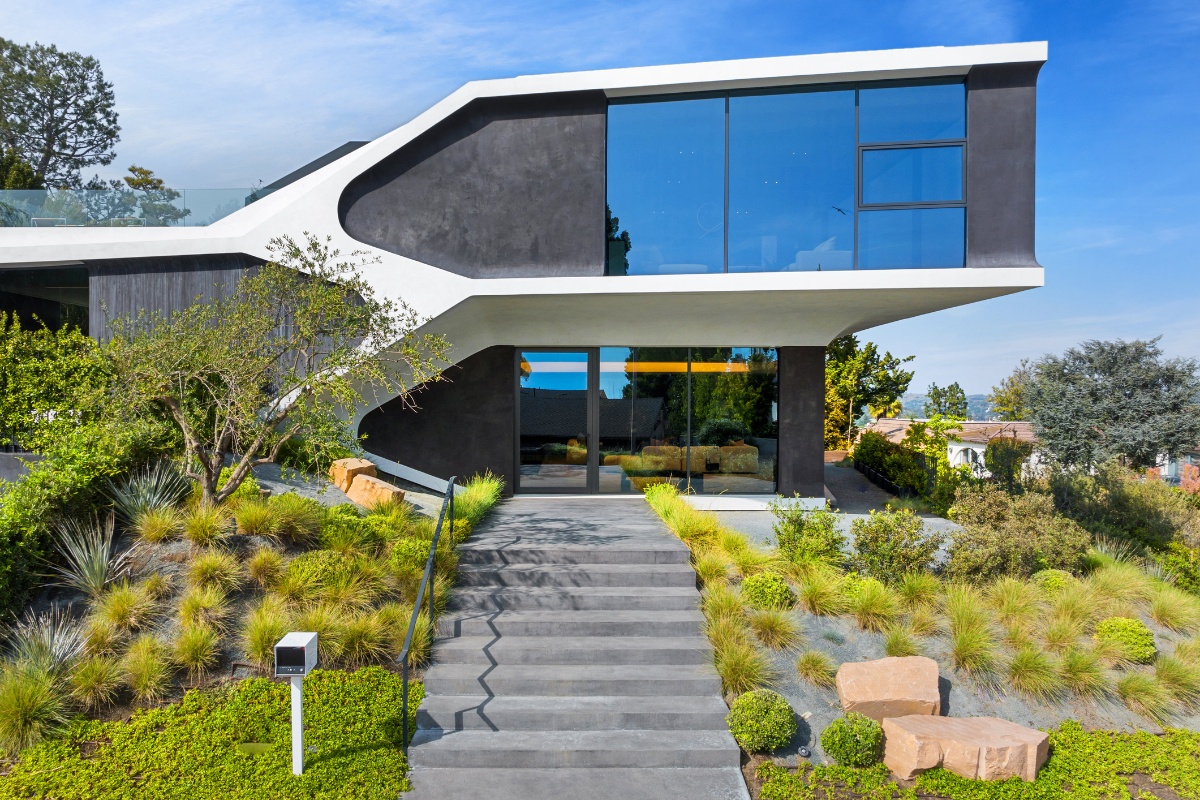Xeriscaping is a water-conscious landscaping method using drought-tolerant plants and efficient irrigation systems
For Pacific Palisades homeowners and luxury real estate investors, the value of a beautiful yet water-efficient landscape cannot be overstated. Enter xeriscaping – a sustainable, low-maintenance front yard landscaping approach that blends seamlessly with Southern California’s natural aesthetic while conserving water.
Table of Contents:
XERISCAPING BASICS

Sustainable design elements can turn your garden into a low-maintenance, eco-friendly oasis
Xeriscaping is a water-conscious landscaping method that uses drought-tolerant plants and efficient irrigation systems to achieve a visually appealing, low-maintenance front yard landscaping solution. Developed in response to frequent droughts in the southwestern US., xeriscaping has since gained popularity across California. This approach is especially attractive to luxury property owners who value an eco-friendly and luxurious landscape.
The main principles of xeriscaping
Xeriscaping revolves around seven foundational principles that help homeowners create sustainable, water-efficient landscapes that are both beautiful and easy to maintain. These principles work together to minimize water use, support healthy plant growth, and achieve a low-maintenance front yard landscaping aesthetic that is especially well-suited for arid climates like Pacific Palisades.
Below, we explore each of these essential principles and how they contribute to a luxurious, drought-tolerant landscape.
- Soil improvement
Soil quality is crucial for successful xeriscaping, as arid climates often lack the nutrients and structure needed for water retention. Adding organic matter like compost, aged manure, or mulch improves soil texture, helping sandy soils retain water and clay soils drain efficiently. This supports healthy, low-maintenance plants that thrive on less water, reducing the need for frequent fertilization and extra treatments.
- Efficient irrigation
Efficient irrigation is key to xeriscaping, maximizing water use while minimizing waste. Unlike traditional sprinklers, which can cause evaporation and runoff, xeriscaping delivers water directly to plant roots through methods like drip irrigation, soaker hoses, or targeted hand-watering. Drip irrigation reduces water usage by up to 60%, and programmable timers and moisture sensors further optimize watering, ensuring plants receive just the right amount of water for healthy, low-maintenance front yard landscaping.
- Water zoning
Water zoning is a key xeriscaping strategy that groups plants with similar water needs into designated zones. High-water-use plants are placed near shaded areas or water features, while low-water-use plants like succulents and native grasses thrive in sun-exposed zones. This method ensures efficient irrigation, conserves resources, and maintains healthy, low-maintenance landscaping while minimizing over- or under-watering.
- Smart landscape design
Smart design is central to xeriscaping, utilizing drought-tolerant plants, hardscapes, and functional layouts to reduce water usage and enhance visual appeal. Traditional grass lawns are replaced with alternatives like native plants, rock gardens, and gravel or flagstone pathways. Hardscapes such as patios and walkways minimize water needs and maintenance, using permeable materials like decomposed granite that allow rainwater to replenish the soil, reducing upkeep and supporting a low-maintenance, sustainable landscape.
- Mulching and ground cover
Mulching is vital in xeriscaping, helping retain soil moisture, moderate temperatures, and suppress weeds. Organic mulches like wood chips and compost enrich the soil, while inorganic options like gravel and decorative rocks offer stylish coverage. For low-maintenance front yard landscaping, mulching reduces watering needs, prevents weed growth, and insulates plant roots – ideal for Pacific Palisades’s dry, sunny climate. Ground covers like creeping thyme further enhance texture and color.
- Use of native and drought-tolerant plants
Native and drought-tolerant plants are essential in xeriscaping, thriving with minimal water. In Pacific Palisades, plants like California poppies, sage, and succulents reduce water needs and support local wildlife, attracting pollinators. These plants enhance resilience, reduce maintenance, and align with low-maintenance front yard landscaping principles. With deep root systems, they access groundwater, making them more drought-resistant and minimizing the need for additional irrigation.
- Ongoing maintenance and adaptation
While xeriscaping is low maintenance, it requires some care, especially during the establishment phase. Once plants are established, maintenance includes occasional weeding, seasonal mulching, and irrigation system checks. As the landscape matures, homeowners may adapt by adding new plants or updating hardscapes. Adapting to changing climate patterns, such as adjusting plant selections or irrigation schedules, ensures long-term resilience and sustainability.
Incorporating these principles of xeriscaping not only creates a stunning, low-maintenance front yard landscaping design but also aligns with Pacific Palisades’ eco-conscious ethos.
BENEFITS OF XERISCAPING FOR PACIFIC PALISADES HOMES

Xeriscaping offers numerous advantages to Pacific Palisades homeowners, blending luxury, environmental sustainability, and aesthetic appeal into one sophisticated landscaping approach. For luxury real estate owners and investors, these benefits extend beyond water savings – they encompass increased property value, ease of maintenance, year-round beauty, and environmental stewardship.
Here’s an in-depth look at the benefits xeriscaping can bring to properties in Pacific Palisades.
Xeriscaping uses up to 75% less water
Traditional lawns can require up to 55 gallons of water per square foot annually, while xeriscaped landscapes use 50-75% less water, thanks to drought-resistant plants, efficient irrigation systems, and strategic water zoning.
For luxury properties with expansive yards, this reduction in water use can translate into significant savings on utility bills, particularly during the hot summer months. Environmentally, reducing household water usage helps alleviate pressure on local water resources and supports broader conservation efforts within the Pacific Palisades community.
Xeriscaping requires less upkeep
Xeriscaping also offers the benefit of low-maintenance landscaping, requiring far less upkeep than traditional lawns. By using native and drought-tolerant plants, xeriscaped gardens minimize the need for frequent watering, pruning, and fertilization. These plants are typically adapted to the local environment, requiring little to no fertilizers or pest control.
For busy homeowners or those who frequently travel, this reduced maintenance is invaluable. Many luxury buyers also seek out properties with low-maintenance landscapes to fit their lifestyles. A xeriscaped yard offers beauty without the need for regular mowing, seasonal planting, or intensive watering, making it an appealing feature for prospective buyers in high-end markets.
Xeriscaping enhances property value
In the luxury real estate market of Pacific Palisades, xeriscaping can be a valuable asset. Sustainable, eco-conscious landscaping is increasingly appealing to today’s buyers, who may be willing to pay a premium for homes with green features like xeriscaping. Real estate professionals often note that sustainable landscaping can enhance a home’s value, as it not only reduces long-term maintenance costs but also aligns with the values of eco-minded buyers.
A thoughtfully designed xeriscaped yard with hardscaping elements – such as stone pathways, pergolas, and custom lighting – enhances curb appeal and gives the property a refined, sophisticated look. Xeriscaping is thus not only a cost-effective investment for homeowners but also a feature that appeals to buyers looking to reduce both utility and maintenance expenses without compromising aesthetics.
Xeriscaping provides year-round curb appeal
Xeriscaping also offers aesthetic beauty year-round, a desirable quality in luxury markets where curb appeal can impact property value. With careful selection of plants, such as succulents, native grasses, and flowering shrubs, a xeriscaped garden can maintain vibrant colors, textures, and forms throughout the year. Unlike traditional lawns, which may brown during droughts or go dormant in cooler months, xeriscaped plants typically retain their appeal regardless of the season.
Pacific Palisades’s climate is well-suited to drought-resistant plants like lavender, sage, and California poppies, which bring color and variety to the landscape. Succulents and cacti add unique shapes and textures, creating a modern, stylish aesthetic. These qualities make xeriscaping both a sustainable and visually appealing choice that enhances curb appeal year-round.
Xeriscaping protects land and marine life
Beyond water conservation, xeriscaping offers important environmental benefits, supporting a greener approach to landscaping. Native plants used in xeriscaping foster biodiversity, creating habitats for pollinators such as bees, butterflies, and birds. This contributes to a healthy local ecosystem, which is especially valuable in urban areas where green space is limited.
Xeriscaping also helps prevent soil erosion by covering the ground with materials like mulch, gravel, and ground covers, which reduces evaporation and protects soil during heavy rain. Additionally, because xeriscaping minimizes the need for pesticides and fertilizers, it reduces the risk of water pollution from chemical runoff. In coastal areas like Pacific Palisades, these environmental benefits are particularly significant, helping to protect both land and marine ecosystems.
Xeriscaping improves the way we live
For luxury homeowners, xeriscaping’s benefits extend to lifestyle enhancements as well. A well-planned xeriscaped garden can be designed as an outdoor sanctuary, complete with seating areas, pathways, and serene, naturalistic views. Since xeriscaping reduces the need for constant maintenance, homeowners can spend more time enjoying their outdoor space rather than tending to it. The inclusion of hardscapes such as stone patios, water features, and low-maintenance front yard landscaping accents like decorative rock arrangements can transform a yard into an ideal setting for entertaining or relaxation.
Furthermore, xeriscaping aligns with a broader trend toward sustainable luxury, a lifestyle choice that’s increasingly valued by affluent homeowners. By investing in an eco-friendly, water-wise landscape, Pacific Palisades property owners can take pride in reducing their environmental footprint while enjoying the benefits of a custom, aesthetically pleasing garden.
HOW TO IMPLEMENT XERISCAPING IN YOUR PROPERTY

Integrating xeriscaping into your landscape design can elevate your Pacific Palisades property with a blend of sustainable and luxurious elements. With the right plants, design techniques, and efficient water management, xeriscaping creates a lush, low-maintenance front yard landscaping that conserves water and reduces upkeep.
Here’s an in-depth look at the essential steps for implementing xeriscaping to maximize both aesthetic appeal and eco-friendly benefits.
-
Choose the right plants
Selecting appropriate plants is one of the most important aspects of xeriscaping success, as it ensures your landscape will thrive with minimal water requirements. In Southern California’s dry Mediterranean climate, native and drought-tolerant plants are ideal because they are naturally adapted to the local environment. Some popular choices include:
- California poppy. Known for its bright orange blooms, the California poppy adds a splash of color and thrives with little water. Its vibrant petals and delicate foliage create a stunning focal point, ideal for low-maintenance front yard landscaping.
- Lavender. This fragrant plant brings both visual appeal and a calming scent to your garden. Lavender’s hardy, drought-tolerant nature and attractive purple flowers make it perfect for xeriscaping.
- Sage. Another water-wise plant, sage is easy to grow and provides subtle greens, purples, and blues, blending beautifully with other native plants. It’s also aromatic and can deter some garden pests, making it a versatile addition.
- Succulents. Known for their unique shapes and colors, succulents like agave, aloe, and echeveria are highly drought-tolerant and low-maintenance. Their bold textures add visual interest and work well as ground cover or in container arrangements.
Incorporating native plants and succulents reduces water usage while adding diverse textures and colors to your yard, enhancing the luxurious feel of your landscape. These plants also tend to be pest-resistant and require minimal fertilization, cutting down on maintenance tasks and helping to create a long-lasting, sustainable landscape design.
-
Incorporate hardscaping
Hardscaping is a crucial element of xeriscaping, as it provides structure, reduces water requirements, and adds an upscale aesthetic to your landscape. Hardscapes – such as pathways, patios, and decorative stone features – can minimize water needs by replacing thirsty grass lawns and framing your planting areas with elegant, functional designs.
Consider the following hardscape options for a luxury xeriscaped yard:
- Stone pathways and patios. Natural stone or pavers can add sophistication to your yard while also offering durable surfaces that require no watering. These hardscapes can be arranged in winding paths or spacious patios, creating outdoor living areas that are both practical and visually appealing.
- Gravel and decorative rocks. Gravel and decorative rocks provide a clean, modern look to any landscape. These elements can be used as ground cover to keep moisture in the soil, prevent weeds, and reduce water usage. Gravel also creates a natural transition between plants and pathways, contributing to a cohesive design.
- Boulders and rock formations. For a more dramatic touch, incorporate boulders and rock formations that add height and structure to your landscape. Strategically placed rocks can anchor planting beds, serve as focal points, and provide visual contrast to the soft greenery of drought-tolerant plants.
These hardscaping elements not only contribute to a low-maintenance front yard landscaping but also enhance the luxury appeal of your home. Well-designed hardscapes require little upkeep, and their durability means they will look pristine for years to come with minimal intervention.
-
Employ efficient irrigation
Water-efficient irrigation is a cornerstone of xeriscaping, as it allows for precise and minimal water use while ensuring plants remain hydrated. Drip irrigation systems are the most effective option, as they deliver water directly to plant roots, reducing evaporation and waste compared to traditional sprinkler systems.
For a low-maintenance front yard landscaping approach, consider the following irrigation strategies:
- Drip irrigation. Drip lines slowly release water to a plant’s root zones, helping to maintain consistent moisture levels without oversaturating the soil. These systems can be easily customized to target specific plant zones, making them ideal for water-conscious landscaping.
- Programmable timers and moisture sensors: To optimize water use, add a programmable timer or moisture sensor to your irrigation system. Timers allow you to set specific watering schedules based on seasonal needs, while moisture sensors detect soil moisture levels and prevent overwatering.
- Rainwater harvesting. For an added layer of sustainability, consider incorporating rainwater harvesting systems, such as rain barrels, which collect and store rainwater that can be used to irrigate your plants. Rainwater harvesting helps reduce reliance on municipal water sources and supports a fully sustainable landscape.
By investing in an efficient irrigation system, homeowners can enjoy a low-maintenance landscape that minimizes water consumption and keeps plants healthy year-round.
-
Opt for mulch and ground cover
Mulching is an essential xeriscaping practice that helps retain soil moisture, reduce erosion, and prevent weeds, making it a vital component of low-maintenance front yard landscaping. Mulch is typically applied around plants and other garden areas, offering both functional and aesthetic benefits.
Popular mulch options include:
- Bark or wood chips. These natural mulches decompose over time, adding nutrients to the soil while retaining moisture. They also create a warm, organic look that complements native plants.
- Gravel or small stones. Ideal for drier landscapes, gravel and small stones can be used as ground cover to reduce evaporation and discourage weed growth. They are also a durable, low-maintenance option that enhances the modern, sophisticated look of a xeriscaped yard.
- Decomposed granite. This fine gravel-like material offers a natural look that blends seamlessly with plants and hardscapes. Decomposed granite is excellent for pathways or as a ground cover in planting areas.
Using mulch effectively can improve soil health, maintain consistent moisture levels, and protect plant roots from extreme temperature changes, reducing the need for frequent watering and creating a robust, sustainable landscape.
PARTNER WITH JAMES RESPONDEK IF YOU’RE BUYING OR SELLING A HOUSE IN PACIFIC PALISADES, CA

Live in the highly desirable neighborhood of Pacific Palisades Village, known for its walkability, access to hiking trails, proximity to the beach, and excellent schools
When buying or selling a home, partnering with an experienced real estate professional like James Respondek and his team ensures you receive the highest level of service and expertise. A skilled negotiator with a proven track record, James Respondek consistently ranks among the top agents nationally. He excels at marketing superior homes in the Westside’s competitive luxury market. His professional, discreet, and agile approach and a deep understanding of cutting-edge marketing trends make him the ideal choice for those seeking to navigate the Pacific Palisades real estate market.
For all your real estate needs in Pacific Palisades, trust the professionals who understand the unique demands of this beautiful coastal community. Call 310.488.4400 or send us an email today.



